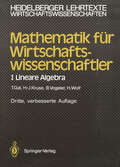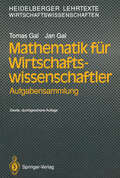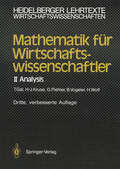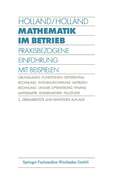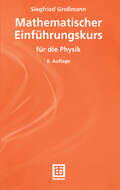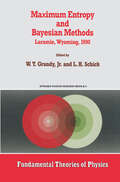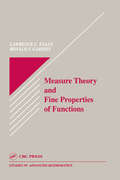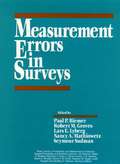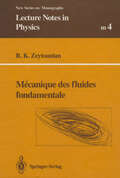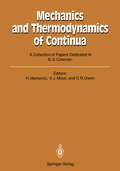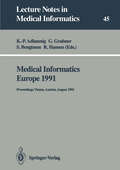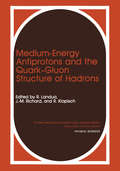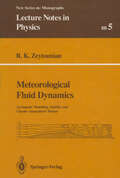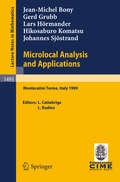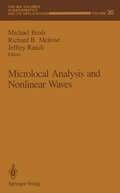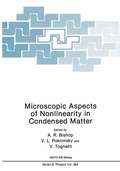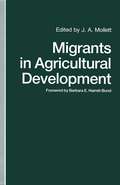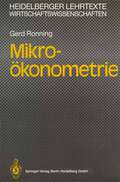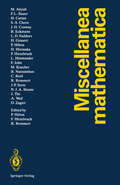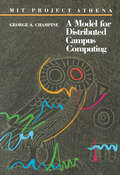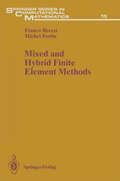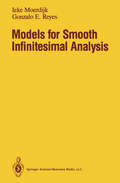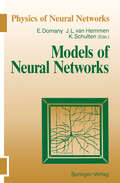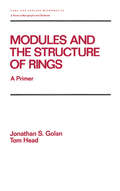- Table View
- List View
Mathematik für Wirtschaftswissenschaftler: I Lineare Algebra (Heidelberger Lehrtexte Wirtschaftswissenschaften)
by Tomas Gal Hermann-Josef Kruse Bernhard Vogeler Hartmut WolfDas vorliegende Buch über Mathematik für Wirtschaftswissenschaftler basiert auf langjährigen Erfahrungen mit dem gleichnamigen Kurs der Fernuniversität Hagen. Die Themenauswahl ist so getroffen, daß sie für die Wirtschafts-, Sozial- und Ingenieurwissenschaften die notwendigen Kenntnisse liefert. Behandelt werden in den einzelnen Kapiteln des Buches die Themen Vektoren, Geometrie im Rn, Matrizen, lineare Gleichungs- und Ungleichungssysteme. Jedes Kapitel ist grundsätzlich in zwei Teile unterteilt, im ersten Teil werden die angesprochenen Themenkreise durch motivierende Beispiele eingeführt, im zweiten Teil mathematisch behandelt. Die Darstellung der Inhalte richtet sich insbesondere an die Zielgruppe der Selbststudierenden. Das bedeutet, daß jeder, der die Lineare Algebra als Grundlage für ein weiteres Studium braucht, durch dieses Buch ein Werk in die Hand bekommt, das es ihm ermöglicht, ohne fremde Hilfe, ohne Vorlesungen oder Vorträge zu besuchen, im Selbststudium die notwendigen Kenntnisse zu erwerben. Die didaktischen Erfahrungen, die an der Fernuniversität in jahrelanger Arbeit gesammelt wurden, werden in diesem Buch einen breiten Leserkreis zugänglich gemacht.
Mathematik für Wirtschaftswissenschaftler: Aufgabensammlung (Heidelberger Lehrtexte Wirtschaftswissenschaften)
by Tomas Gal Jan GalDas vorliegende Buch ist als Begleittext zu dem Lehrbuch Mathematik für Wirtschaftswissenschaftler gedacht, kann aber auch unabhängig davon benutzt werden. Es beinhaltet Aufgaben zum selbständigen Durcharbeiten zu allen Themen der Wirtschaftsmathematik, wobei zu einzelnen schwierigen Aufgaben Anleitungen vorhanden sind und am Ende eine ausführliche Lösung mit Lösungsweg angegeben ist. Für den Leser bringt die Durcharbeitung dieses Buches den Vorteil, daß er die Materie der Wirtschaftsmathematik nicht nur besser versteht, sondern auch viel besser behalten kann, so daß es ihm später leichter fällt, die Mathematik bei der Lösung praktischer Probleme zu nutzen.
Mathematik für Wirtschaftswissenschaftler: II Analysis (Heidelberger Lehrtexte Wirtschaftswissenschaften)
by Tomas Gal Hermann-Josef Kruse Gabriele Piehler Bernhard Vogeler Hartmut WolfDas vorliegende Buch über Mathematik für Wirtschaftswissenschaftler basiert auf langjährigen Erfahrungen mit dem gleichnamigen Kurs der Fernuniversität Hagen. Die Themenauswahl ist so getroffen, daß sie für die Wirtschafts-, Sozial- und Ingenieurwissenschaften die notwendigen Kenntnisse liefert. Behandelt werden Funktionen einer und mehrerer Variablen, die Differential- und Integralrechnung. Jedes Kapitel ist grundsätzlich in zwei Teile unterteilt, im ersten Teil werden die angesprochenen Themenkreise durch motivierende Beispiele eingeführt, im zweiten Teil mathematisch behandelt. Die Darstellung der Inhalte richtet sich insbesondere an die Zielgruppe der Selbststudierenden. Das bedeutet, daß jeder, der die Analysis als Grundlage für ein weiteres Studium braucht, durch dieses Buch ein Werk in die Hand bekommt, das es ihm ermöglicht, ohne fremde Hilfe, ohne Vorlesungen oder Vorträge zu besuchen, im Selbststudium die notwendigen Kenntnisse zu erwerben. Die didaktischen Erfahrungen, die an der Fernuniversität in jahrelanger Arbeit gesammelt wurden, werden in diesem Buch einem breiten Leserkreis zugänglich gemacht.
Mathematischer Einführungskurs für die Physik (Teubner Studienbücher Physik)
by Siegfried GroßmannStudierende, die ein Physikstudium aufnehmen, brauchen zu Beginn vor allem eines: mathematische Grundkenntnisse. Da es sich hierbei zunächst um einen relativ beschränkten und charakteristischen Ausschnitt aus der Mathematik handelt, werden die benötigten Kompetenzen vor allem im Rahmen von Tutorien oder Arbeitsgruppen vermittelt. Dieser Einführungskurs soll Studierenden im ersten Semester helfen, die Inhalte dieser Veranstaltungen zu vertiefen und möglichst rechtzeitig die Fähigkeiten zu erwerben, die ein erfolgreiches Physikstudium garantieren.
Maximum Entropy and Bayesian Methods: Laramie, Wyoming, 1990 (Fundamental Theories of Physics #43)
by W. T. Grandy Jr. L. H. SchickThe 10th International Workshop on Maximum Entropy and Bayesian Methods, MaxEnt 90, was held in Laramie, Wyoming from 30 July to 3 August 1990. This volume contains the scientific presentations given at that meeting. This series of workshops originated in Laramie in 1981, where the first three of what were to become annual workshops were held. The fourth meeting was held in Calgary. the fifth in Laramie, the sixth and seventh in Seattle, the eighth in Cambridge, England, and the ninth at Hanover, New Hampshire. It is most appropriate that the tenth workshop, occurring in the centennial year of Wyoming's statehood, was once again held in Laramie. The original purpose of these workshops was twofold. The first was to bring together workers from diverse fields of scientific research who individually had been using either some form of the maximum entropy method for treating ill-posed problems or the more general Bayesian analysis, but who, because of the narrow focus that intra-disciplinary work tends to impose upon most of us, might be unaware of progress being made by others using these same techniques in other areas. The second was to introduce to those who were somewhat aware of maximum entropy and Bayesian analysis and wanted to learn more, the foundations, the gestalt, and the power of these analyses. To further the first of these ends, presenters at these workshops have included workers from area. s as varied as astronomy, economics, environmenta.
Measure Theory and Fine Properties of Functions
by LawrenceCraig EvansThis book provides a detailed examination of the central assertions of measure theory in n-dimensional Euclidean space and emphasizes the roles of Hausdorff measure and the capacity in characterizing the fine properties of sets and functions. Topics covered include a quick review of abstract measure theory, theorems and differentiation in Mn, lower Hausdorff measures, area and coarea formulas for Lipschitz mappings and related change-of-variable formulas, and Sobolev functions and functions of bounded variation. The text provides complete proofs of many key results omitted from other books, including Besicovitch's Covering Theorem, Rademacher's Theorem (on the differentiability a.e. of Lipschitz functions), the Area and Coarea Formulas, the precise structure of Sobolev and BV functions, the precise structure of sets of finite perimeter, and Alexandro's Theorem (on the twice differentiability a.e. of convex functions).Topics are carefully selected and the proofs succinct, but complete, which makes this book ideal reading for applied mathematicians and graduate students in applied mathematics.
Measure Theory and Fine Properties of Functions
by LawrenceCraig EvansThis book provides a detailed examination of the central assertions of measure theory in n-dimensional Euclidean space and emphasizes the roles of Hausdorff measure and the capacity in characterizing the fine properties of sets and functions. Topics covered include a quick review of abstract measure theory, theorems and differentiation in Mn, lower Hausdorff measures, area and coarea formulas for Lipschitz mappings and related change-of-variable formulas, and Sobolev functions and functions of bounded variation. The text provides complete proofs of many key results omitted from other books, including Besicovitch's Covering Theorem, Rademacher's Theorem (on the differentiability a.e. of Lipschitz functions), the Area and Coarea Formulas, the precise structure of Sobolev and BV functions, the precise structure of sets of finite perimeter, and Alexandro's Theorem (on the twice differentiability a.e. of convex functions).Topics are carefully selected and the proofs succinct, but complete, which makes this book ideal reading for applied mathematicians and graduate students in applied mathematics.
Measurement Errors in Surveys (Wiley Series in Probability and Statistics #173)
by Paul P. Biemer Robert M. Groves Lars E. Lyberg Nancy A. Mathiowetz Seymour SudmanWILEY-INTERSCIENCE PAPERBACK SERIES The Wiley-Interscience Paperback Series consists of selected books that have been made more accessible to consumers in an effort to increase global appeal and general circulation. With these new unabridged softcover volumes, Wiley hopes to extend the lives of these works by making them available to future generations of statisticians, mathematicians, and scientists. "This book will be an aid to survey statisticians and to research workers who must work with survey data." –Short Book Reviews, International Statistical Institute Measurement Errors in Surveys documents the current state of the field, reports new research findings, and promotes interdisciplinary exchanges in modeling, assessing, and reducing measurement errors in surveys. Providing a fundamental approach to measurement errors, the book features sections on the questionnaire, respondents and responses, interviewers and other means of data collection, the respondent-interviewer relationship, and the effects of measurement errors on estimation and data analysis.
Mecanique des fluides fondamentale (Lecture Notes in Physics Monographs #4)
by Radyadour K. ZeytounianCe cours de mecanique des fluides est avant tout un cours theorique qui repond aux questions fondamentales de ce sujet de recherche. Les quatre premiers chapitres presentent les equations propres a determiner l'ecoulement de fluide considere et diverses solutions. Les chapitres 5 et 6sont consacres aux problemes lies la stabilite, aux bifurcations et aux comportements chaotiques. Le livre donne un vision globale des questions traitees en mecanique des fluides qui sont a la base de toute la recherche, de la modelisation et de toutes les applications dans ce domaine.
Mechanics and Thermodynamics of Continua: A Collection of Papers Dedicated to B.D. Coleman on His Sixtieth Birthday
by Hershel Markovitz Victor J. Mizel David R. OwenReprinted from Archive for Rational Mechanics and Analysis edited by C. Truesdell
Medical Informatics Europe 1991: Proceedings, Vienna, Austria, August 19–22, 1991 (Lecture Notes in Medical Informatics #45)
by Klaus-Peter Adlassnig Georg Grabner Stellan Bengtsson Rolf HansenThis volume contains the proceedings of the Tenth International Congress on Medical Informatics, MIE 91, that will be held in Vienna, Austria, August 19-22, 1991. The MIE 91 Congress was organized by the European Federation for Medical Informatics (EFMI) in cooperation with the Austrian Computer Society (OCG) and the Austrian Society for Biomedi cal Engineering (OGBMT). It follows the previous congresses in Cambridge (1978), Berlin (1979), Toulouse (1981), Dublin (1982), Brussels (1984), Helsinki (1985), Rome (1987), Oslo (1988), and the Congress 1990 in Glasgow. The proceedings contain 199 contributions to the MIE 91 Congress. They cover all presentations which are part of the scientific programme of MIE 91, among them 157 paper presentations with an average of five pages, 28 poster presentations again with an average of five pages, and 14 abstracts of demonstrations with an average of one page. The papers included were selected by an International Programme Committee out of over 300 submissions after careful review by at least two international reviewers (for whose estimable efforts we are especially thankful). The recommendations of the re viewers were incorporated in the final texts. Some papers were reworked by a professional translator to obtain a high quality of presentation. Several submissions could not be considered for presenta tion at MIE 91 because of shortage of congress time and limitations in the number of pages of the proceedings.
Medium-Energy Antiprotons and the Quark—Gluon Structure of Hadrons (Ettore Majorana International Science Series #58)
by R. Klapisch R. Landua J. M. RichardThe fourth course of the International School on Physics with Low Energy Antiprotons was held in Erice, Sicily, at the Ettore Majorana Centre for Scientific Culture from 25 to 31 January, 1990. The previous courses covered topics related to fundamental symmetries, light and heavy quark spectroscopy, and antiproton-nucleus interactions. The purpose of this school is to review theoretical and experimental aspects of low energy antiproton physics concerning the quark-gluon structure of hadrons and the dynamics of the. antiproton-nucleon interaction. Another important objective is the discussion of future directions of research with low-and medium-energy antiprotons in the context of future medium energy facilities at CERN and elsewhere. These proceedings contain both the tutorial lectures and the various contributions presented during the school by the participants. The proceedings have been organised in three sections. The first section is devoted to the theoretical lectures and contributions. The selection of the various subjects wants to emphasize the correlation between antiproton-nucleon physics and the underlying description in terms of quarks and gluons. The second section contains an overview about 35 years of experiments with antiprotons. It gives an introduction to the particle physics aspects of the field by outlining the historical development of experiment and theory, and by describing the motivation and the results of three recent LEAR experiments in more detail. The third section contains most of the contributions of the participants describing in more detail certain aspects of current or planned experiments at LEAR.
Meteorological Fluid Dynamics: Asymptotic Modelling, Stability and Chaotic Atmospheric Motion (Lecture Notes in Physics Monographs #5)
by Radyadour K. ZeytounianThe author considers meteorology as a part of fluid dynamics. He tries to derive the properties of atmospheric flows from a rational analysis of the Navier-Stokes equations, at the same time analyzing various types of initial and boundary problems. This approach to simulate nature by models from fluid dynamics will be of interest to both scientists and students of physics and theoretical meteorology.
Microlocal Analysis and Applications: Lectures given at the 2nd Session of the Centro Internazionale Matematico Estivo (C.I.M.E.) held at Montecatini Terme, Italy, July 3-11, 1989 (Lecture Notes in Mathematics #1495)
by J. M. Bony G. Grubb L. Hörmander H. Komatsu J. SjöstrandMicrolocal Analysis and Nonlinear Waves (The IMA Volumes in Mathematics and its Applications #30)
by Michael Beals Richard B. Melrose Jeffrey RauchThis IMA Volume in Mathematics and its Applications MICROLOCAL ANALYSIS AND NONLINEAR WAVES is based on the proceedings of a workshop which was an integral part of the 1988- 1989 IMA program on "Nonlinear Waves". We thank Michael Beals, Richard Melrose and Jeffrey Rauch for organizing the meeting and editing this proceedings volume. We also take this opportunity to thank the National Science Foundation whose financial support made the workshop possible. A vner Friedman Willard Miller, Jr. PREFACE Microlocal analysis is natural and very successful in the study of the propagation of linear hyperbolic waves. For example consider the initial value problem Pu = f E e'(RHd), supp f C {t ;::: O} u = 0 for t < o. If P( t, x, Dt,x) is a strictly hyperbolic operator or system then the singular support of f gives an upper bound for the singular support of u (Courant-Lax, Lax, Ludwig), namely singsupp u C the union of forward rays passing through the singular support of f.
Microscopic Aspects of Nonlinearity in Condensed Matter (Nato Science Series B: #264)
by Alan R. Bishop V. L. Pokrovsky V. TognettiProceedings of a NATO ARW held in Florence, Italy, June 7--13, 1990
Migrants in Agricultural Development: A Study of Intrarural Migration
by J.A. MollettA study which examines the economic rationale for migration and its effect on agricultural development. It features case studies of rural-to-rural migration in 10 countries, making a comparative assessment of forced and spontaneous migration.
Miscellanea Mathematica
by M. Atiyah F. L. Bauer H. Cartan S. S. Chern J. H. Conway B. Eckmann L. D. Faddeev H. Grauert P. Hilton H. Hironaka F. Hirzebruch L. Hörmander F. John M. Koecher R. Narasimhan C. Reid R. Remmert J-P. Serre N.J.A. Sloane J. Tits A. Weil D. ZagierMIT Project Athena: A Model for Distributed Campus Computing
by Bozzano G LuisaA hands-on account of the design, implementation, and performance of Project Athena. Based on thousands of pages of reports and the author's own experience, this important book lets you in on the design, implementation, and performance of Project Athena - now a production system of networked workstations that is replacing time-sharing (which MIT also pioneered) as the preferred model of computing at MIT. The book is organized in four parts, covering management, pedagogy, technology, and administration. Appendixes describe deployment of Project Athena systems at five other schools, provide guidelines for installation, and recommend end-user policies.
Mixed and Hybrid Finite Element Methods (Springer Series in Computational Mathematics #15)
by Franco Brezzi Michel FortinResearch on non-standard finite element methods is evolving rapidly and in this text Brezzi and Fortin give a general framework in which the development is taking place. The presentation is built around a few classic examples: Dirichlet's problem, Stokes problem, Linear elasticity. The authors provide with this publication an analysis of the methods in order to understand their properties as thoroughly as possible.
Models for Smooth Infinitesimal Analysis
by Ieke Moerdijk Gonzalo E. ReyesThe aim of this book is to construct categories of spaces which contain all the C?-manifolds, but in addition infinitesimal spaces and arbitrary function spaces. To this end, the techniques of Grothendieck toposes (and the logic inherent to them) are explained at a leisurely pace and applied. By discussing topics such as integration, cohomology and vector bundles in the new context, the adequacy of these new spaces for analysis and geometry will be illustrated and the connection to the classical approach to C?-manifolds will be explained.
Models of Neural Networks (Physics of Neural Networks)
by Eytan Domany J. Leo Van Hemmen Klaus SchultenOne of the great inteJlectual cha1lenges for the next few decades is the question of brain organization. What is the basic mechanism for storage of memory? What are the processes that serve as the interphase between the basically chemical processes of the body and the very specific and nonstatistical operations in the brain? Above all. how is concept formation achieved in the human brain? I wonder whether the spirit of the physics that will be involved in these studies will not be akin to that which moved the founders of the ''rational foundation of thermodynamics". CN. Yangl 10 The human brain is said 10 have roughly 10 neurons connected through about 14 10 synapses. Each neuron is itself a complex device which compares and integrates incoming electrical signals and relays a nonlinear response to other neurons. The brain certainly exceeds in complexity any system which physicists have studied in the past. Nevertheless, there do exist many analogies of the We have witnessed during the last decade brain to simpler physical systems.
Modules and the Structure of Rings: A Primer
by GolanThis textbook is designed for students with at least one solid semester of abstract algebra,some linear algebra background, and no previous knowledge of module theory. Modulesand the Structure of Rings details the use of modules over a ring as a means of consideringthe structure of the ring itself--explaining the mathematics and "inductivereasoning" used in working on ring theory challenges and emphasizing modules insteadof rings.Stressing the inductive aspect of mathematical research underlying the formal deductivestyle of the literature, this volume offers vital background on current methods for solvinghard classification problems of algebraic structures. Written in an informal butcompletely rigorous style, Modules and the Structure of Rings clarifies sophisticatedproofs ... avoids the formalism of category theory ... aids independent study or seminarwork ... and supplies end-of-chapter problems.This book serves as an excellent primary.text for upper-level undergraduate and graduatestudents in one-semester courses on ring or module theory-laying a foundation formore advanced study of homological algebra or module theory.
